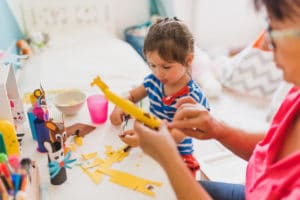Don’t worry: Your child will be taught to write in elementary school. Your child doesn’t have to be able to recognize letters when he or she starts school. However, you can support your little one in kindergarten if he or she is particularly interested in the mysterious signs used by adults.
Here you can also find out how the complex process of learning to write works.
Table of contents
Kindergarten: First Contact With Written Language
Parents don’t have to worry – children learn to write and read in elementary school. No one expects children to master something they are first taught. Some toddlers take an early interest in the mysterious signs that surround them.
Thus, some toddlers try to write their name or first small sentences like “Ana mak Lisa”. Children who write down their first words have understood the most important principle of alphabetic writing.
When learning to write, spoken sounds are transformed into letters. If four-year-olds are already inquisitive and curious about learning to write, there is nothing to stop them from supporting their early eagerness to learn. Parents should definitely not play school, but support the children in a playful way.
For example, write down the letters and words that the child wants you to say or read individual words or letters aloud. When reading out letters, the following rule applies: do not read out the respective letter name, but the letter sound.
Also interesting:So, for example, “b” instead of “be”. Singing together and playing language games can also promote phonemic understanding. It is also helpful to hang up a poster with large letters and a matching initial sound picture (A=monkey) in the children’s room.
By the way, in the preschool of the kindergarten the first swinging exercises are made and the correct pen posture is practiced. At home, you can easily train your child’s motor skills. Whether it’s kneading dough, peeling and cutting vegetables, or making your own sandwiches – anything that trains the hands is effective.
Learning To Write In Elementary School: The Different Learning Methods
Learning to write is an interplay of a wide variety of cognitive skills. Visual, auditory and motor skills play an important role in the acquisition of written language. But how does learning to write work for elementary school students? What happens before a child is able to write a text?
As with learning to read, a so-called phonetic table is used in the classroom. On this table, a picture is printed for each letter and the respective word is written next to it. An example of this would be: M for mummy or H for house.
Using these pictures, the first graders can recognize what the first letter looks like. With the help of the phonetic table, even beginners with no previous knowledge can quickly learn to write and read. Children should first write down the words as they hear them.
The written words are not corrected by the teacher for the time being. This helps the children to overcome their inhibitions. This method is nowadays additionally supplemented by so-called “orthography exercises”, as otherwise some students might memorize the wrong spelling.
Another method used in the classroom is the so-called “primer teaching”. The children learn the letters little by little. Eventually, the individual letters are put together to form words.
First, simple words such as “notebook,” “bread,” or “dog” are learned. These are written exactly as they are pronounced. Special features such as “ei” or “au” are learned a little later.
With this method, spelling errors are corrected from the beginning. Most teachers use a mix of different learning methods. To positively influence the motivation of beginning spellers, spelling errors are not corrected at first.
However, as the first grade progresses, children are slowly introduced to correct spelling. However, there is no one correct method for learning to write and read. While higher-performing students learn to write regardless of the method chosen, for lower-performing students, structured instruction is most important.
What Is The Best Way To Help Children Learn To Write?
There are several ways you can help your child learn to write and read:
- Playful motor exercises and exercises for fine motor skills: painting and kneading strengthens the fingers and trains motor skills.
- Regular reading aloud awakens enthusiasm for the written word and your child develops a feeling for language.
- Give your child patience and time to master the great challenge of learning to write.
- There are several ABC and letter learning apps that make learning to write easier.

This Is Why Handwriting Is So Important With Students
In this age of digitalization, some frustrated students may wonder why handwriting is still important these days. After all, there are computers, tablets and smartphones that save us the hassle of writing by hand.
Of course, the offspring are right in some respects – nowadays we receive postcards and letters almost exclusively via e-mail. Shopping lists, notes and appointments are saved on the smartphone. Anyone who makes a spelling or grammatical error is corrected thanks to automatic spell recognition.
Nevertheless, it is worth the effort to learn handwriting. Four areas in both hemispheres of the brain work together in the process of writing to keep our brains on their toes.
The movement of the hand, the recognition of grammar and the meaning of a word are processed simultaneously and finally the composition of the individual letters into whole words takes place.
In the process, a massive rebuilding process takes place and countless synapses are formed. In addition, handwriting helps us to better remember what we have written. We create so-called memory traces in our brain when forming the letters, which are immediately activated when we encounter the letters again.
However, typing on the computer and smartphone has no relationship to the shape of the letters, so such processes do not occur.
How Do Multilingual Children Learn To Write?
Many children today grow up multilingual. Some of them have parents with two different native languages. Some also learn a different language at home than at school. Children have an innate language acquisition ability that can be put to excellent use by age 7.
This means that children have a fine ear for the different sounds of a language. They orient themselves to the spoken languages in their environment. Multilingual education can have a positive effect on a child’s development.
In some cases, however, it can lead to difficulties in learning to read and write, for example, when children form incorrect grammatical sentences or confuse word endings. It is therefore important that children first learn the written language in their first language. Only then does the child learn the orthography of the second language.
Problems in learning to write: Dyslexia And Isolated Spelling Disorder
When learning to write, some children are sometimes suspected of having a reading-spelling disorder. Sometimes certain difficulties are already noticeable at home. In many cases, teachers also notice that something is wrong.
Since the acquisition of written language is very complex, you don’t have to worry if your child makes mistakes at the beginning. These mistakes are perfectly normal. However, if these errors persist beyond a certain developmental age, it could indicate dyslexia.
In what is known as dyslexia, children have persistent difficulties in the process of reading and writing. However, if there is below-average intelligence, brain damage or mental illness, this diagnosis may not be made.
In some cases, a spelling disorder also occurs in isolation. This means that children can learn to read according to the average and only have difficulty writing text and spelling correctly.
For students who have problems learning to write, there are support programs and therapies. A professional learning therapist will first make a comprehensive diagnosis. After the diagnosis has been clarified, therapy works on the symptoms and strengthens the child’s self-esteem.













1 thought on “Learning To Write Made Easy: How Children Learn To Write In Elementary School”